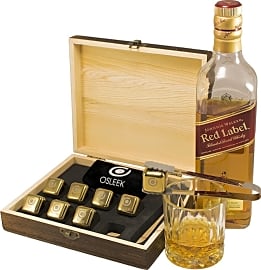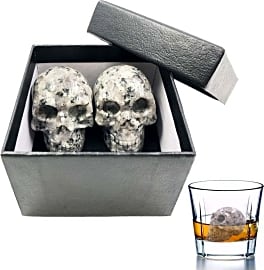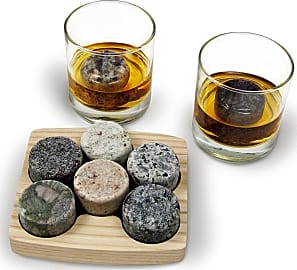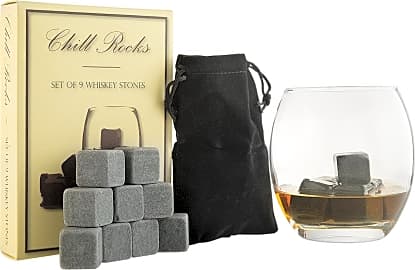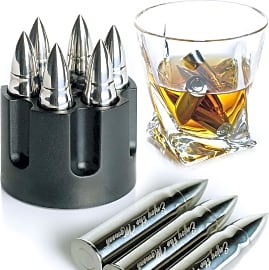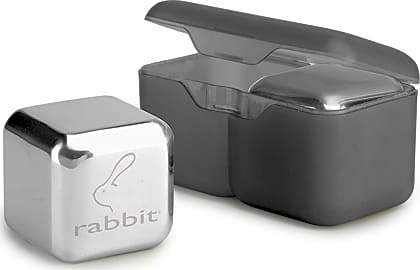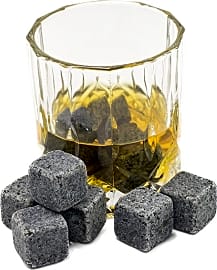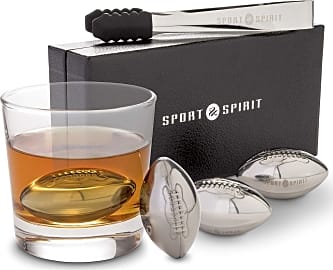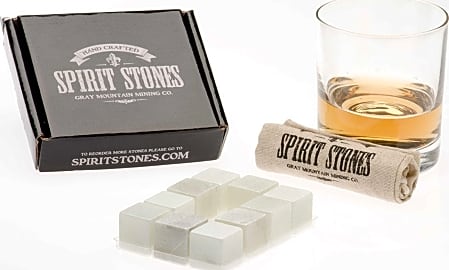The 10 Best Whisky Stones

This wiki has been updated 38 times since it was first published in September of 2015. If you like your drinks on the rocks but hate to dilute an expensive single malt you carried all the way home from Scotland, try a set of these whisky stones. Coming in an assortment of shapes and styles, and made from various materials, they will give you the right temperature for your beverages without compromising taste. They are also great for cooling white wine, beer, and soda. When users buy our independently chosen editorial picks, we may earn commissions to help fund the Wiki.
Editor's Notes
February 07, 2020:
During this round of updates, we removed the Balls of Steel, Whiskey And Axe Premium Set Of Six and BarMe Steel Bullets, all due to availability issues. We were, however, able to replace the latter offering with the similarly styled Tangriland Silver Bullets, which comes with a nifty storage apparatus that’s thematically designed in the likeness of a revolver cylinder. Some of our other new additions include the Two Nines Gift Set – a pack of granite dice that double as whiskey stones and come with a pair of crystal tumblers, and the Palksky Bone Chill Rocks – a pair of granite stones that come hand carved into the likeness of miniature human skulls.
A few things to keep an eye out for in this category:
Material: Whiskey stones can be made from a variety of materials. In addition to the inherent stylistic qualities that come with each type (which we’ll get into shortly), there’s some practical considerations to bear in mind as well. The three main types of material whiskey stones are made of are:
Soapstone: As a soft stone, soapstone is less likely to leave a blemish on your fine crystal glassware, but it doesn’t do the best job of cooling your drink.
Granite: As a harder stone, granite tends to be more durable, but also more prone to scratching glasses. However, options like the hand-carved Palksky Bone Chill Rocks are polished smooth to neutralize this issue. To add more to the positive side, granite stones cool off relatively quickly in the freezer, and do a good job of passing that temperature back off to your beverage of choice.
Stainless Steel: Stainless-steel stones tend to not be made of solid steel, and are typically actually stainless-steel shells filled with a cooling agent that, as in the case of the Tangriland Silver Bullets, can be something as simple as a 95%-purified-water, 5%-alcohol solution. Though their smooth surfaces can be a bit slippery to get a grip on once wet (especially after a celebratory libation or two), these stones are well reputed for effectively chilling spirits.
Style: This an entirely personal consideration, but one that every whiskey fan will need to face on their quest to buy a decent set of stones. While stainless-steel models tend to evoke a sleek, modern feel, soapstone and granite options tend to embody more of an organic, rustic look. Specialty stones like the Sport & Spirit Cooling Rocks 3MKS LLC and Two Nines Gift Set, which are made in the semblance of footballs and game die, appeal to niche audiences and can be a great rec room accessory for the right user.
Extras: Not only are whiskey stones an asset for an enthusiast, but they also make a great gift for your drinking buddies (and one that comes with an implicit invitation to sample their good stuff the next time you visit). With that in mind, consider an option like the Two Nines Gift Set that comes in a presentable wooden box with a pair of crystal glasses and matching coasters. Or the Sport & Spirit Cooling Rocks 3MKS LLC, which comes with a pair of rubber-grip tongs and a handy mesh storage bag.
A note on drinking temperature:
One reoccurring complaint that comes up with whiskey stones is that they don’t cool spirits as effectively as ice. In fact, on top of diluting the spirit as they melt, ice cubes are often responsible for cooling spirits beyond their ideal temperature, which (depending who you talk to and exactly what you’re drinking) is considered to be somewhere in the neighbourhood of 40 to 60 degrees Fahrenheit. So, if well-frozen whiskey stones aren’t doing enough for you in the cooling department, there’s a good chance you’re drinking your whiskey “too cold.”
If cold whiskey’s your preference, all the power to you, you’ll get no judgement from me – I’ll even confess to having been guilty of “ruining” a few good glasses of scotch in this manner, myself. But, you might want to consider sticking to ice or, if dilution is still a problem you’re trying to combat, perhaps just chilling the bottle itself in a freezer or mini fridge.
A Brief History Of Whisky
Flavored and super-premium options are especially popular, particularly among women, who have traditionally been hesitant to embrace bourbons and ryes.
Whether you call it moonshine, white lightning, rotgut, corn squeezin's, ol-lickety stump, the pine dragon, or anything else, a smooth, flavorful whisky is one of the few things with the potential to unite all peoples, colors, and creeds (also, I may have made a couple of those names up).
The first use of distilled spirits dates all the way back to the Babylonians in the 2nd millennium B.C.E., but whisky came along much later. There's some dispute as to whether it originated in Scotland or Ireland, but wherever it started, it became popular sometime around the 15th century.
Originally called "water of life," whisky was distilled by monks and used as medicine in its early days. Eventually, the Scottish king James IV discovered that he'd grown quite fond of this new medicine, and his court bought a massive amount of booze from the Guild of Barber Surgeons — for medicinal purposes, of course.
Meanwhile, in England, Henry VIII was in the middle of separating the Church of England from the Catholic Church. To that end, he disbanded all the monasteries in the country — sending the monks into the general population, along with their knowledge of whisky-making.
At this point, English subjects incorporated the stuff into their daily lives, so it's only natural that they'd take it with them once they moved to the Colonies across the pond. It became so popular during and after the American Revolution, in fact, that it was often used as currency, and the burgeoning federal government learned the hard way not to tax it excessively.
Kentucky quickly became a hotbed for distilleries, as it had ample access to grain, as well as clean, limestone-filtered water. This led to the development of bourbon, which is still the greatest thing America has ever given the world.
Whisky continued to be extremely popular until the passage of Prohibition in 1920. Despite the new law, "medicinal whisky" was legal, provided you had a prescription from a doctor. In what is surely an unrelated coincidence, the Walgreens pharmacy chain grew by 2,000 percent during this time.
Despite a brief lull in popularity during the latter half of the 20th century, whisky is now one of the fastest-growing sectors of the alcohol market. Flavored and super-premium options are especially popular, particularly among women, who have traditionally been hesitant to embrace bourbons and ryes. Similarly, its popularity is growing overseas, as well, with countries like Russia, India, and Poland discovering their taste for the strong stuff.
The future for whisky looks bright, as production steadily increases and niche markets continually emerge. After all, as anyone who has ever woken up without pants can tell you, you can never have too much whisky.
The Benefits Of Whisky Stones
If you've ever seen someone drinking whisky on the rocks — not over ice, but over actual honest-to-God rocks — you might have thought to yourself, "Just what are those things, anyway?"
Congratulations — you've encountered whisky stones. Usually made of soapstone, granite, or metal, these objects keep your drink cold without diluting it. They're also reusable, so you never have to worry about running out of ice (unless you forget to put them back in the freezer when you're done, of course).
This is especially useful if you drink bourbons with high alcohol content.
Stainless steel is generally considered the best material for whisky stones, as they won't wear down over time or leave chunks of stone in your glass. They also get cold more quickly, can be cleaned in the dishwasher, and have inherent anti-bacterial properties. They are usually more expensive, however, although the price difference is fairly negligible.
Whisky stones aren't for everyone, of course. Many people like having a splash of water in their booze, and it's been shown that watering down whisky can actually release a more complex flavor profile. This is especially useful if you drink bourbons with high alcohol content.
In fact, they may not even cool drinks as well as ice, as the water mixes with the whisky in a form of highly-efficient energy transfer. If you need that drink quickly, and you need it cool, ice is still the undefeated champ.
That said, any well-stocked bar includes at least a couple of whisky stones. Different people have different tastes — and a good host is capable of getting everyone equally drunk, regardless of their preferences.
The Best Way To Enjoy Whisky
If you're the type who just fills your glass and chugs it down, then you're missing out on some of the subtler pleasures that whisky can give you.
The important thing to keep in mind here is that the best way to enjoy whisky is whichever way you like best.
The first thing you need to do, of course, is to pick your poison. American whiskys — including rye and bourbon — tend to be a little sweeter, while scotch is usually smokier. Other countries have their own options, each with their own flavor profile, but the only way to find your favorite is to try as many as possible (you have our permission).
Once you've found a few selections that work for you, the next consideration is the glass you'll be drinking it out of. Most people prefer low tumblers, but if you really want to get the full flavor experience, a tulip-shaped glass helps concentrate the aromas. You can also drink from a tin cup, which gives you an authentic, old-timey experience, but really doesn't do much for the taste.
After that, it's simply a matter of finding the right combination of flavors for you. Do you like it on the rocks, or neat? With a splash of water, or neat? Mixed in with a cocktail...or neat? (You get the idea.)
The important thing to keep in mind here is that the best way to enjoy whisky is whichever way you like best. There are no wrong answers.
Well, unless you enjoy it so much that you find yourself waking up in a jail cell the next morning. Then there might have been some wrong answers along the way.


